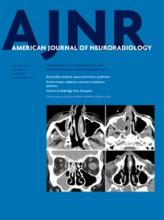Abstract
BACKGROUND AND PURPOSE: Treating MS with disease-modifying drugs relies on accurate MR imaging follow-up to determine the treatment effect. We aimed to develop and validate a semiautomated software platform to facilitate detection of new lesions and improved lesions.
MATERIALS AND METHODS: We developed VisTarsier to assist manual comparison of volumetric FLAIR sequences by using interstudy registration, resectioning, and color-map overlays that highlight new lesions and improved lesions. Using the software, 2 neuroradiologists retrospectively assessed MR imaging MS comparison study pairs acquired between 2009 and 2011 (161 comparison study pairs met the study inclusion criteria). Lesion detection and reading times were recorded. We tested inter- and intraobserver agreement and comparison with original clinical reports. Feedback was obtained from referring neurologists to assess the potential clinical impact.
RESULTS: More comparison study pairs with new lesions (reader 1, n = 60; reader 2, n = 62) and improved lesions (reader 1, n = 28; reader 2, n = 39) were recorded by using the software compared with original radiology reports (new lesions, n = 20; improved lesions, n = 5); the difference reached statistical significance (P < .001). Interobserver lesion number agreement was substantial (≥1 new lesion: κ = 0.87; 95% CI, 0.79–0.95; ≥1 improved lesion: κ = 0.72; 95% CI, 0.59–0.85), and overall interobserver lesion number correlation was good (Spearman ρ: new lesion = 0.910, improved lesion = 0.774). Intraobserver agreement was very good (new lesion: κ = 1.0, improved lesion: κ = 0.94; 95% CI, 0.82–1.00). Mean reporting times were <3 minutes. Neurologists indicated retrospective management alterations in 79% of comparative study pairs with newly detected lesion changes.
CONCLUSIONS: Using software that highlights changes between study pairs can improve lesion detection. Neurologist feedback indicated a likely impact on management.
ABBREVIATIONS:
- CSP
- comparative study pairs
- CSSC
- conventional side-by-side comparison
- IL
- improved lesion
- NL
- new lesion
- VTS
- VisTarsier software
- © 2015 by American Journal of Neuroradiology












